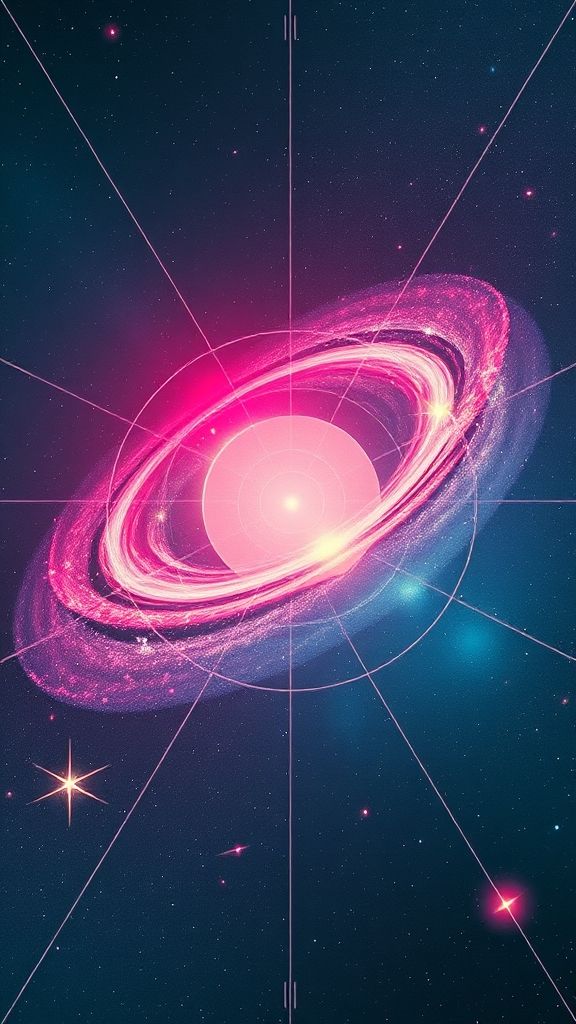Quantum Physicists Crack Code With Breakthrough Thermometer That Reveals Hidden Quantum Secrets
Physicists have successfully created a thermometer that can measure the “quantumness” of …
04. October 2025

A team of astronomers has unveiled a groundbreaking astronomical phenomenon known as “Einstein’s Cross” surrounding the enigmatic galaxy HerS-3. The finding provides a unique opportunity to study a distant galaxy in unprecedented detail and reveals the existence of a massive dark matter halo lurking at the heart of a galaxy group.
The incredible observation was made possible by gravitational lensing, where light from a distant source is bent and magnified by the gravitational field of a foreground object. This effect allows astronomers to “zoom in” on regions of the universe that would otherwise be inaccessible due to their vast distances. The team used gravitational lensing to focus on HerS-3, an object located approximately 12 billion light-years away.
The initial analysis revealed that HerS-3 appears to be a bright starburst galaxy - a type of galaxy that experiences explosive star formation and is thought to have formed at a time when star formation was at its peak throughout the universe. This realization has significant implications for our understanding of galaxy evolution, as it suggests that HerS-3 may have undergone a rapid period of star formation in the distant past.
Observations also revealed that HerS-3 possesses a unique characteristic: a tilted, rotating disk from which gas is escaping at a furious rate. This feature is reminiscent of active galactic nuclei (AGN), which are thought to be powered by supermassive black holes residing at the centers of galaxies. The presence of this disk and the associated outflow of gas suggests that HerS-3 may have undergone a merger with another galaxy, leading to the formation of a new, massive galaxy.
The fascinating discovery was made possible by the precise application of gravitational lensing models. By carefully analyzing the distortion of light caused by the four giant galaxies between HerS-3 and Earth, the team identified the Einstein’s Cross effect - where the light from HerS-3 is split into five distinct images. Initially, it seemed as though these images could be explained solely by the gravitational lensing generated by the foreground galaxies.
However, when the team employed a sophisticated model of gravitational lensing to study the system in greater detail, they found that the observable mass of the four giant galaxies was insufficient to produce the observed arrangement of the five images. In other words, their masses were not sufficient to account for the remarkable configuration of the Einstein’s Cross.
The only way to reproduce the remarkable configuration we observed was to add an invisible, massive component: a dark matter halo at the center of the galaxy group, declared lead author Pierre Cox from the Institut d’Astrophysique de Paris. This realization opens up new avenues of research into the nature of dark matter and its role in shaping the structure of galaxies.
Dark matter is a mysterious entity that makes up approximately 85% of the universe’s total mass-energy budget, yet it remains invisible to our telescopes. Its presence is inferred through its gravitational effects on visible matter, such as stars and galaxies. The detection of this dark matter halo around HerS-3 represents a significant breakthrough in understanding the nature of dark matter and its relationship with normal matter.
This discovery has far-reaching implications for our understanding of galaxy evolution and the distribution of mass within galaxy clusters. By studying the properties of dark matter halos, researchers can gain insights into the formation and evolution of galaxies over billions of years.
The team’s findings highlight the importance of combining cutting-edge astronomical techniques, such as gravitational lensing, with sophisticated computational models to unravel the secrets of the universe. The study also serves as a testament to human curiosity and scientific inquiry - an ongoing quest to understand the workings of our cosmos through meticulous observation, rigorous analysis, and innovative research.
As astronomers continue to explore the vast expanse of the universe, discoveries like this one serve as a reminder that even in the most distant reaches of space, there is still much to be uncovered. The existence of Einstein’s Cross around HerS-3 has sparked new avenues of investigation into the mysteries of dark matter and galaxy evolution - an ongoing quest that promises to reveal even more secrets about our cosmos.
The observation provides a unique opportunity for astronomers to study the properties of dark matter halos in unprecedented detail, shedding light on the nature of this mysterious entity. By analyzing the distribution and motion of stars and gas within the halo, researchers can gain insights into its composition, structure, and evolution over time.
The discovery also has significant implications for our understanding of galaxy evolution and the formation of galaxies over billions of years. By studying the properties of dark matter halos, researchers can gain a better understanding of how galaxies form and evolve, and how they interact with their surroundings.
The study’s results are based on data collected from the Hubble Space Telescope and other astronomical observatories around the world. The team’s findings were published in a recent issue of the Astrophysical Journal, providing a comprehensive overview of their research and its implications for our understanding of the universe.
In conclusion, the discovery of Einstein’s Cross surrounding HerS-3 represents a significant breakthrough in our understanding of dark matter and galaxy evolution. By combining cutting-edge astronomical techniques with sophisticated computational models, researchers can unravel the secrets of the universe and gain insights into the nature of this mysterious entity. As astronomers continue to explore the vast expanse of the universe, discoveries like this one serve as a reminder that there is still much to be uncovered about our cosmos.